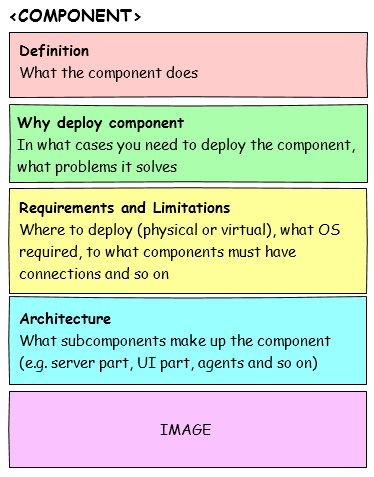Component
A component topic describes a component of a solution architecture.
When to Use Component Topic
Every solution architecture is comprised of a set of components. Use this topic type in case you want to describe one of these components, explain how it works and show how it interacts with other components in the architecture.
How to Use Component Topic
This topic structure consists of the following elements:
- Title — the name of an architecture component.
Use a title that consists of the name of the component.
- Definition — a definition of the architecture component.
Describe what this component is about: for what purposes it is intended, what its functions are, and what it does.
- Rationale — reasons for the component deployment.
Explain why users could need to deploy the component and what its benefits are (if any).
- Requirements — requirements for the component deployment.
List main hardware and software requirements that must be met to deploy the component:
- Platform (physical or virtual) on which the component can be deployed.
- Types of supported OSes.
- Software that must be installed on the machine where the component will run.
- Permissions that must be assigned to users and user groups who will have access to the component.
- Other solution components and infrastructure objects to which the component must have connections.
Do not dive too deep into details. For example, do not list all supported platform versions or OSes — this is what the System Requirements section is for.
- [Optional] Architecture — services, modules and components installed along with the component.
If the component has a complex architectural structure, describe this structure (for example, the server part, UI part, embedded DB and so on).
- [Optional] Limitations — limitations that exist for the component.
- [Optional] Diagram — an illustration of the component.
If you describe the component architecture, add a diagram that illustrates this architecture.
Example
Veeam Backup & Replication Console [title] The Veeam Backup & Replication console is a client-side component that provides access to the backup server. The console lets you log in to Veeam Backup & Replication and perform all kinds of data protection and disaster recovery operations as if you work on the backup server. [definition] You can install as many remote consoles as you need so that multiple users can access Veeam Backup & Replication simultaneously. Veeam Backup & Replication prevents concurrent modifications on the backup server. If several users are working with Veeam Backup & Replication at the same time, the user who saves the changes first has the priority. Other users will be prompted to reload the wizard or window to get the most recent information about the changes in the configuration database. If you have multiple backup servers in the backup infrastructure, you can connect to any of them from the same console. For your convenience, you can save several shortcuts for these connections. [rationale] A machine on which you install the Veeam Backup & Replication console must meet the following requirements: [requirements]
To allow a user to log in to Veeam Backup & Replication through the console, you must add the user to the Local Users group on the backup server or to a group of domain users who have access to the backup server. A scope of operations that the user can perform depends on the role assigned to the user in Veeam Backup & Replication. For more information, see Assigning Roles to Users. [requirements: permissions] When you install a remote console on a machine, Veeam Backup & Replication installs the following components: [architecture]
The Veeam Backup & Replication console has the following limitations: [limitations]
|
